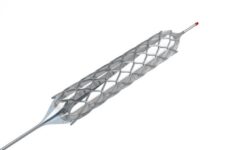Original title: Long-term outcomes after stenting versus endarterectomy for treatment of symptomatic carotid stenosis: the International Carotid Stenting Study (ICSS) randomised trial. Reference: Bonati LH et al. Lancet. 2014;Epub ahead of print. Carotid stenting is an alternative to endarterectomy though long term efficacy remains unknown. This study reports the long term follow up of the International Carotid…
Invasive Strategies Improve Quality of Life in Claudicants
Original title: Improved Quality of Life After One Year With an Invasive Versus a Non-Invasive Treatment Strategy in Claudicants: One Year Results of the IRONIC Trial. Reference: Joakim Nordanstig et al. CIRCULATIONAHA.114.009867. Published online before print August 2014. The quality of studies comparing invasive vs. non-invasive strategies in claudicants is low or very low and, most frequently, consist…
Proximal protection devices could be the first choice for most carotid artery stenting procedures
Original title: Evaluation of proximal protection devices during carotid artery stenting as the first choice for embolic protection. Reference: Hornung M et al. EuroIntervention. 2014; Epub ahead of print. This series of the Frankfurt CardioVascular Center included 124 consecutive patients undergoing carotid angioplasty with proximal protection. The first 92 patients received the Gore Flow Reversal System (WL Gore;…
Superficial Femoral Artery In-Stent Restenosis with Drug Eluting Balloon: 2 Year Follow Up.
Original title: Drug-Eluting Balloons for the Treatment of the Superficial Femoral Artery In-Stent Restenosis. 2-Year Follow-Up. Reference: Vittorio Virga et al. J Am Coll Cardiol Intv 2014;7:411–5. Although the use of the self-expanding nitinol stent has improved angioplasty outcomes in femoropopliteal territory, restenosis remains a challenge still affecting at least 25% of the population in the first year.…
Angioplasty versus surgery in patients with critical lower limb ischemia
Original title: Comparative effectiveness of endovascular andsurgical revascularization for patients with peripheralartery disease and critical limb ischemia: Systematicreview of revascularization in critical limb ischemia. Reference: W Schuyler Jones, et al. (Am Heart J 2014; 167:167:489-498.e7) Lower limbs critical ischemia is the most severe condition of PAD. The morbidity, mortality and costs related thereto are well documented; however, the…
Filter use in inferior vena cava for unstable elderly patients with pulmonary embolism reduces mortality.
Original title: Vena cava filters in unstable elderly patients with acute pulmonary embolism Reference: Stein PD et al. Am J Med. 2014 Mar;127(3):222-5. Filters in inferior vena cava may reduce mortality in patients with severe pulmonary embolism (PE) who are hemodynamically unstable. This has not been demonstrated in elderly patients, a growing demographic group where the…
Ruptured abdominal aortic aneurysm: lower mortality with endovascular treatment at an experienced center.
Original title: Mortality from ruptured abdominal aortic aneurysms: clinical lessons from a comparison of outcomes in England and the USA. Reference: Karthikesalingam A et al. Lancet. 2014;383:963-969. Treatment strategy for rAAA patients may vary according to the different centers. This study analyzed in-hospital mortality, and mortality after intervention of all patients admitted with rAAA between 2005 and 2010…
Prophylactic vena cava filters in trauma patients effectively reduces pulmonary embolism
Original title: The effectiveness of prophylactic inferior vena cava filters in trauma patients: a systematic review and meta-analysis. Reference: Haut ER et al. JAMA Surg. 2014;149:194-202. Trauma is one of the strongest risk factors for pulmonary embolism (PE). Current guidelines recommend low molecular weight heparin therapy which have been proved effective; however, trauma patients often present high risk…
Endovascular treatment in critical limb ischemia, better permeability with similar mortality and amputation than surgery.
Original title: Comparative effectiveness of endovascular and surgical revascularization for patients with peripheral artery disease and critical limb ischemia. Reference: W. Schuyler Jones et al. American Heart Journal 2014. Epub ahead of print. Critical limb ischemia is the most severe condition affecting patients with peripheral vascular disease. Mortality, morbidity, and costs associated with this condition are…
The ball drug is effective in the femoropopliteal area
Original title: Drug-Eluting Balloon in Peripheral Intervention for the Superficial Femoral Artery. The DEBATE-SFA Randomized Trial (Drug Eluting Balloon in Peripheral Intervention for Superficial Femoral Artery). Reference: Liistro, F, el tal. J Am Coll Cardiol Intv 2013;6(12):1295-1302 The current treatment of choice in the femoropopliteal area is angioplasty, however, this procedure has a high rate of restenosis…
Amputation, one of worse prognostic variables
Original title: Lower Extremity Amputation: Factors Associated With Mortality or Contralateral Amputation Reference: Samir K. Shah, et; al. Vascular and Endovascular Surgery 2013:47 (8):608-613. Peripheral vascular disease is associated with trophic injuries with tissue lose, often leading to amputation, of which about 50 % were major amputations. 454 amputations in 391 patients were analyzed, 63 were contralateral. Most…










